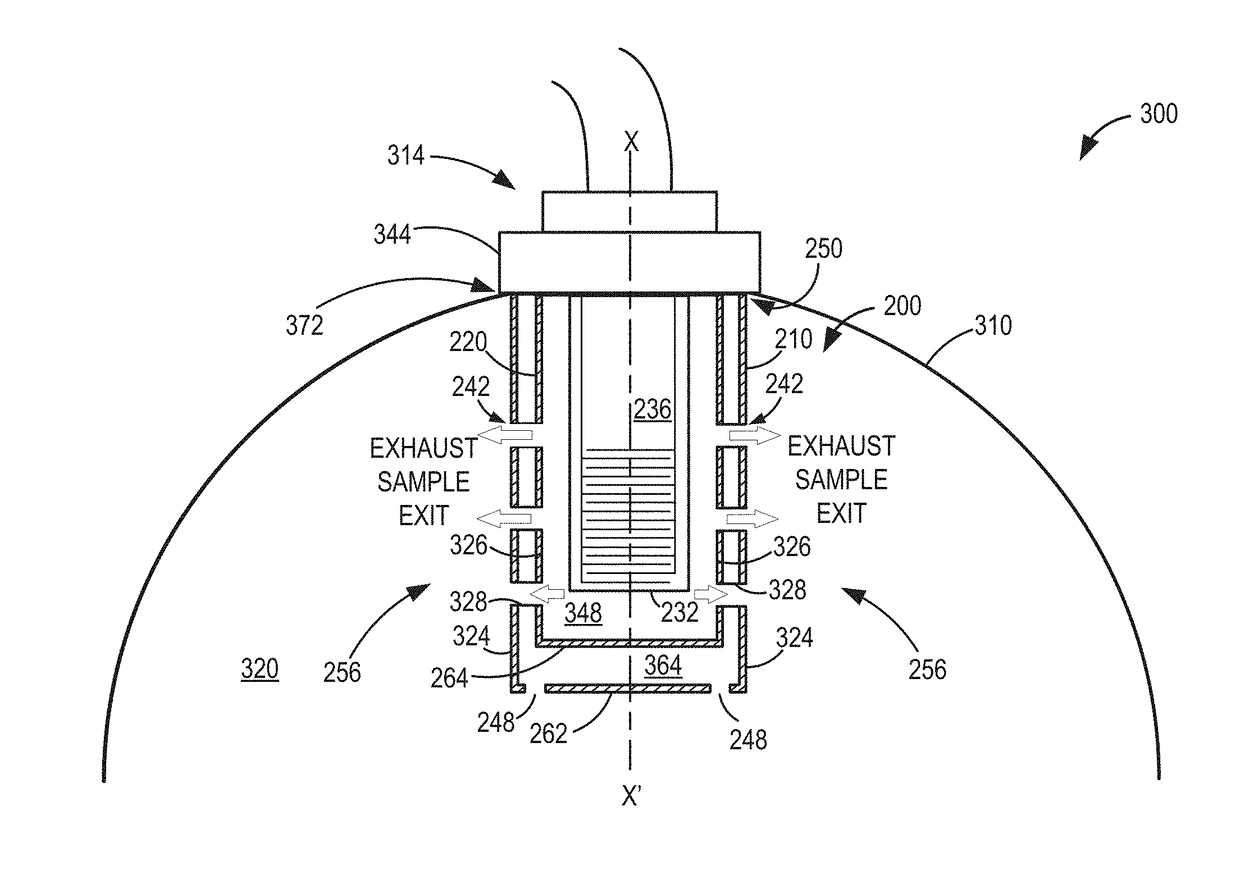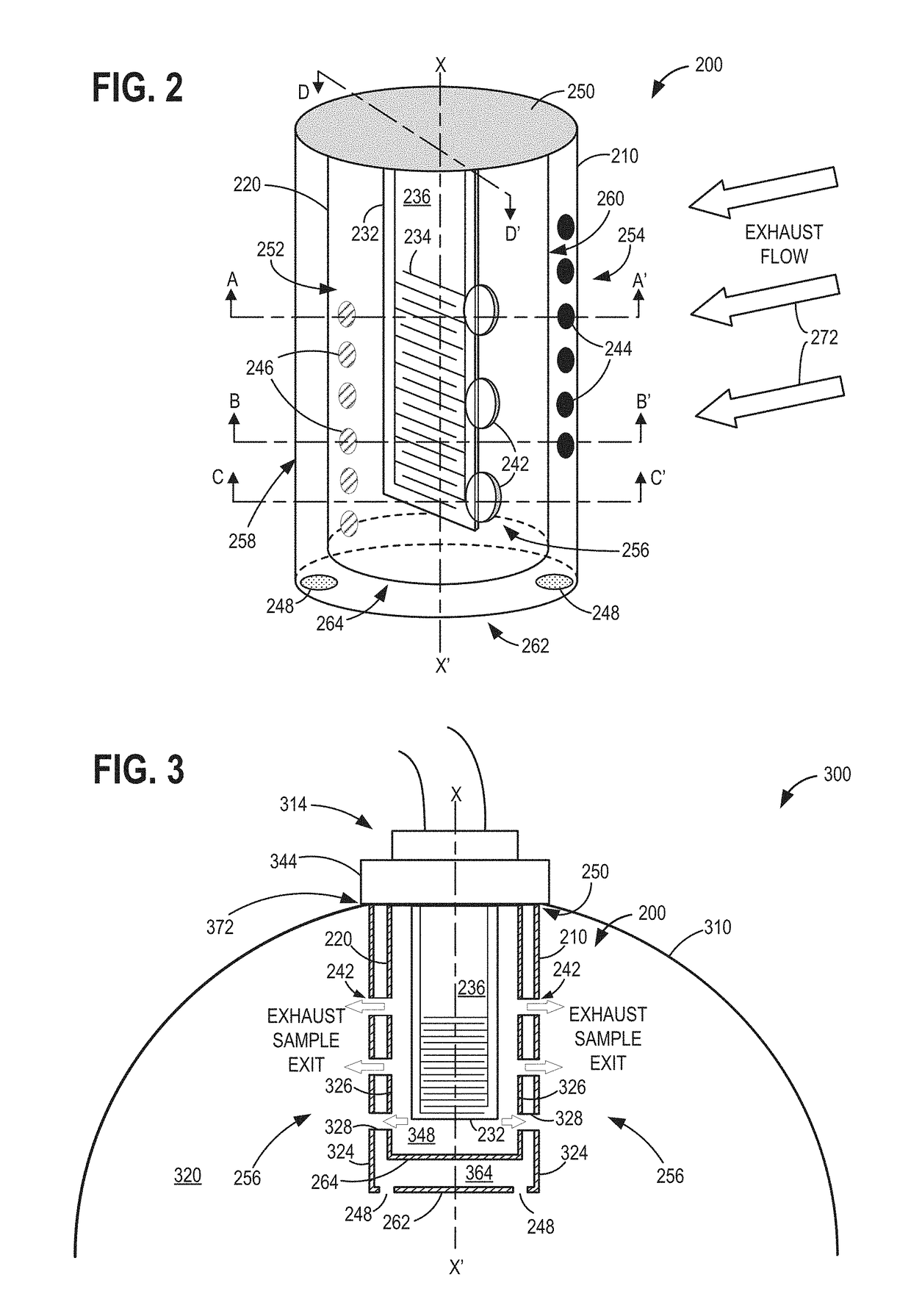System for sensing particulate matter
a technology of particulate matter and exhaust system, which is applied in the direction of mechanical equipment, machines/engines, instruments, etc., can solve the problems of non-uniform deposition of soot on the sensor, prone to contamination of particulate matter sensors, and difficulty in detecting particulate matter, so as to reduce heat loss, improve the functioning of pm sensors, and reduce the effect of particulate deposition
- Summary
- Abstract
- Description
- Claims
- Application Information
AI Technical Summary
Benefits of technology
Problems solved by technology
Method used
Image
Examples
third embodiment
[0021]The following description relates to sensing particulate matter (PM) in an exhaust flow of an engine system, such as the engine system shown in FIG. 1. A PM sensor may be placed in an exhaust passage of the engine system, as shown in FIG. 3. The PM sensor assembly may include a first outer tube with apertures on an upstream surface and a second inner tube with apertures on a downstream surface (FIG. 2). The PM sensor may be enclosed within the second inner tube. A portion of exhaust gases may be drawn into the first outer tube of the PM sensor assembly whereupon the portion of gases may flow within an annular space between the first outer tube and the second inner tube and eventually enter the second inner tube (FIGS. 4a, 4b, and FIG. 7). The portion of exhaust gases may then impinge on a surface of the PM sensor bearing an electrical circuit. Finally, the portion of exhaust gases may exit the inner tube via channels on side surfaces of the PM sensor assembly as shown in FIGS....
embodiment 800
[0078]Turning now to FIG. 8, it portrays an alternative embodiment 800 of the PM sensor assembly 200 of FIGS. 2-4. PM sensor assembly 800 is formed in a similar manner to PM sensor assembly 200 but is arranged in an exhaust passage in an opposite orientation. Specifically, PM sensor assembly 800 is arranged such that the intake apertures on the first outer tube are on a downstream surface of the first outer tube. Additionally, intake apertures on the second inner tube are positioned on an upstream surface of second inner tube. In other words, PM sensor assembly 800 is positioned in reverse orientation to PM sensor assembly 200 with respect to direction of exhaust flow from the DPF.
[0079]In the embodiment shown in FIG. 8, exhaust gases flow from the left hand side to the right hand side of FIG. 8. Thus, PM sensor assembly 800 is portrayed from an upstream perspective. An arrangement such as the one in FIG. 8 may be used in engines with larger displacements wherein an exhaust mass flo...
embodiment 1100
[0092]Turning now to FIG. 11, it portrays yet another embodiment 1100 of a PM sensor assembly. Specifically, embodiment 1100 features a single protective tube surrounding the PM sensor unlike PM sensor assemblies 200 and 800 which feature two protective tubes around their respective PM sensors.
[0093]In the embodiment shown in FIG. 11, exhaust gases flow from the right hand side to the left hand side of FIG. 11. Thus, PM sensor assembly 1100 is viewed from a downstream perspective.
[0094]PM sensor assembly 1100 includes a protective tube 1120 with a plurality of intake apertures 1146 on a downstream surface 1152 of protective tube 1120. An upstream surface 1154 of protective tube 1120 is substantially normal to and faces oncoming exhaust gas flow. Protective tube 1120 also includes multiple exit apertures 1148 on its side surfaces 1156. Further, a PM sensor 1132 may be positioned within protective tube 1120. A first surface 1136 of PM sensor 1132 may feature an electrical circuit 1134...
PUM
| Property | Measurement | Unit |
|---|---|---|
| mass | aaaaa | aaaaa |
| concentration | aaaaa | aaaaa |
| flow rate | aaaaa | aaaaa |
Abstract
Description
Claims
Application Information
 Login to View More
Login to View More - R&D
- Intellectual Property
- Life Sciences
- Materials
- Tech Scout
- Unparalleled Data Quality
- Higher Quality Content
- 60% Fewer Hallucinations
Browse by: Latest US Patents, China's latest patents, Technical Efficacy Thesaurus, Application Domain, Technology Topic, Popular Technical Reports.
© 2025 PatSnap. All rights reserved.Legal|Privacy policy|Modern Slavery Act Transparency Statement|Sitemap|About US| Contact US: help@patsnap.com



